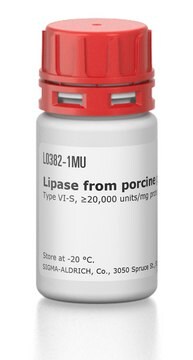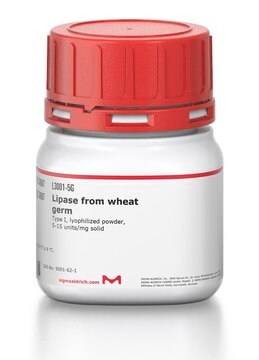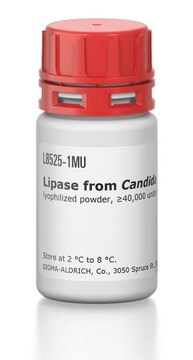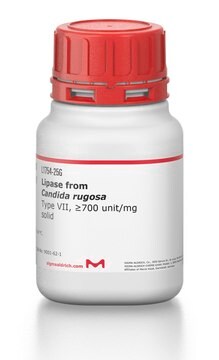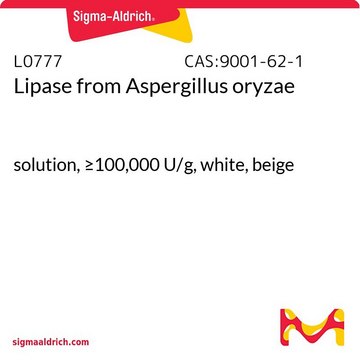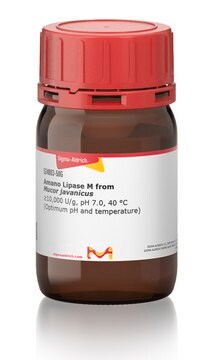L9031
Lipase from Mucor miehei
lyophilized powder, ≥4,000 units/mg solid (using olive oil)
Synonym(s):
Triacylglycerol acylhydrolase, Triacylglycerol lipase
Sign Into View Organizational & Contract Pricing
All Photos(1)
About This Item
Recommended Products
form
lyophilized powder
Quality Level
specific activity
≥4,000 units/mg solid (using olive oil)
storage temp.
2-8°C
InChI
1S/C11H9N3O2.Na/c15-8-4-5-9(10(16)7-8)13-14-11-3-1-2-6-12-11;/h1-7,16H,(H,12,14);/q;+1/b13-9-;
InChI key
QWZUIMCIEOCSJF-CHHCPSLASA-N
Looking for similar products? Visit Product Comparison Guide
Related Categories
General description
Lipase is produced by several animals, microbes, and plants. Lipase from Mucor sp. is a fungal lipase. It is a member of the serine hydrolase family.
Application
Lipase from Mucor miehei can be used to drive the synthesis of flavor esters.
Lipase from Mucor miehei has been used in a study to assess the nonthermal effect of microwave irradiation in nonaqueous enzymatic esterification. It has also been used in a study to investigate the hydrolysis of virgin coconut oil using immobilized lipase in a batch reactor.
Lipases are used industrially for the resolution of chiral compounds and the transesterification production of biodiesel.
Biochem/physiol Actions
Mucor miehei lipase hydrolizes triglycerides and catalyzes the synthesis of esters from glycerol and long-chain fatty acids in vitro. Tri-, di-, and monoglycerides are hydrolyzed (in decreasing order of rate).
Microbial lipase has a wide industrial application due to its stability, broad substrate specificity, and selectivity. It may be used in the synthesis of biosurfactants and finds application in organic chemical processing, dairy industry, oleochemical industry, detergent formulations, paper, cosmetics, nutrition, and the pharmaceutical industry.
Tri-, di-, and monoglycerides are hydrolyzed (in decreasing order of rate).
Unit Definition
One unit will hydrolyze 1.0 microequivalent of fatty acid from a triglyceride in 1 hr at pH 7.7 at 37 °C using olive oil.
Analysis Note
Protein determined by biuret.
Signal Word
Danger
Hazard Statements
Precautionary Statements
Hazard Classifications
Resp. Sens. 1
Storage Class Code
11 - Combustible Solids
WGK
WGK 1
Flash Point(F)
Not applicable
Flash Point(C)
Not applicable
Personal Protective Equipment
dust mask type N95 (US), Eyeshields, Gloves
Choose from one of the most recent versions:
Already Own This Product?
Find documentation for the products that you have recently purchased in the Document Library.
Customers Also Viewed
Torben Snabe et al.
Chemistry and physics of lipids, 133(1), 37-49 (2004-12-14)
Removal of lipidic molecules from surfaces can be accomplished using detergents containing lipases. Surface cleaning is usually performed under alkaline conditions due to increased solubility of the hydrolysis products, especially free fatty acids. This paper shows that removal of a
Agnieszka Stobiecka
Journal of photochemistry and photobiology. B, Biology, 80(1), 9-18 (2005-06-21)
Steady-state and time-resolved fluorescence-quenching measurements have been performed to study multitryptophan lipase from filamentous fungus Rhizomucor miehei. Using the steady-state acrylamide fluorescence quenching data and the fluorescence-quenching-resolved-spectra (FQRS) method, the total emission spectrum of native ("closed-lid") lipase has been decomposed
H S Ryu et al.
Applied microbiology and biotechnology, 70(3), 321-326 (2005-08-10)
A Photobacterium strain, M37, showing lipolytic activity, was previously isolated from an intertidal flat of the Yellow Sea in Korea and identified as Photobacterium lipolyticum sp. nov. In the present study, the corresponding gene was cloned using the shotgun method.
Lee Suan Chua et al.
Enzyme research, 2012, 542589-542589 (2012-09-07)
Hydrolysis of virgin coconut oil (VCO) had been carried out by using an immobilised lipase from Mucor miehei (Lipozyme) in a water-jacketed batch reactor. The kinetic of the hydrolysis was investigated by varying the parameters such as VCO concentration, enzyme
Hui-da Wan et al.
Applied biochemistry and biotechnology, 166(6), 1454-1462 (2012-01-21)
Microwave has nonthermal effects on enzymatic reactions, mainly caused by the polarities of the solvents and substrates. In this experiment, a model reaction with caprylic acid and butanol that was catalyzed by lipase from Mucor miehei in alkanes or arenes
Our team of scientists has experience in all areas of research including Life Science, Material Science, Chemical Synthesis, Chromatography, Analytical and many others.
Contact Technical Service

